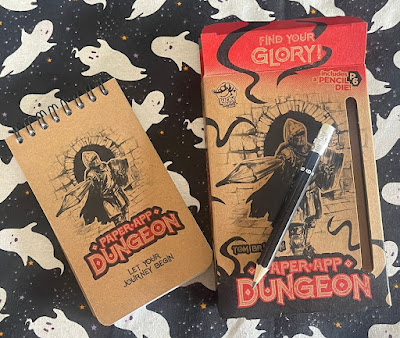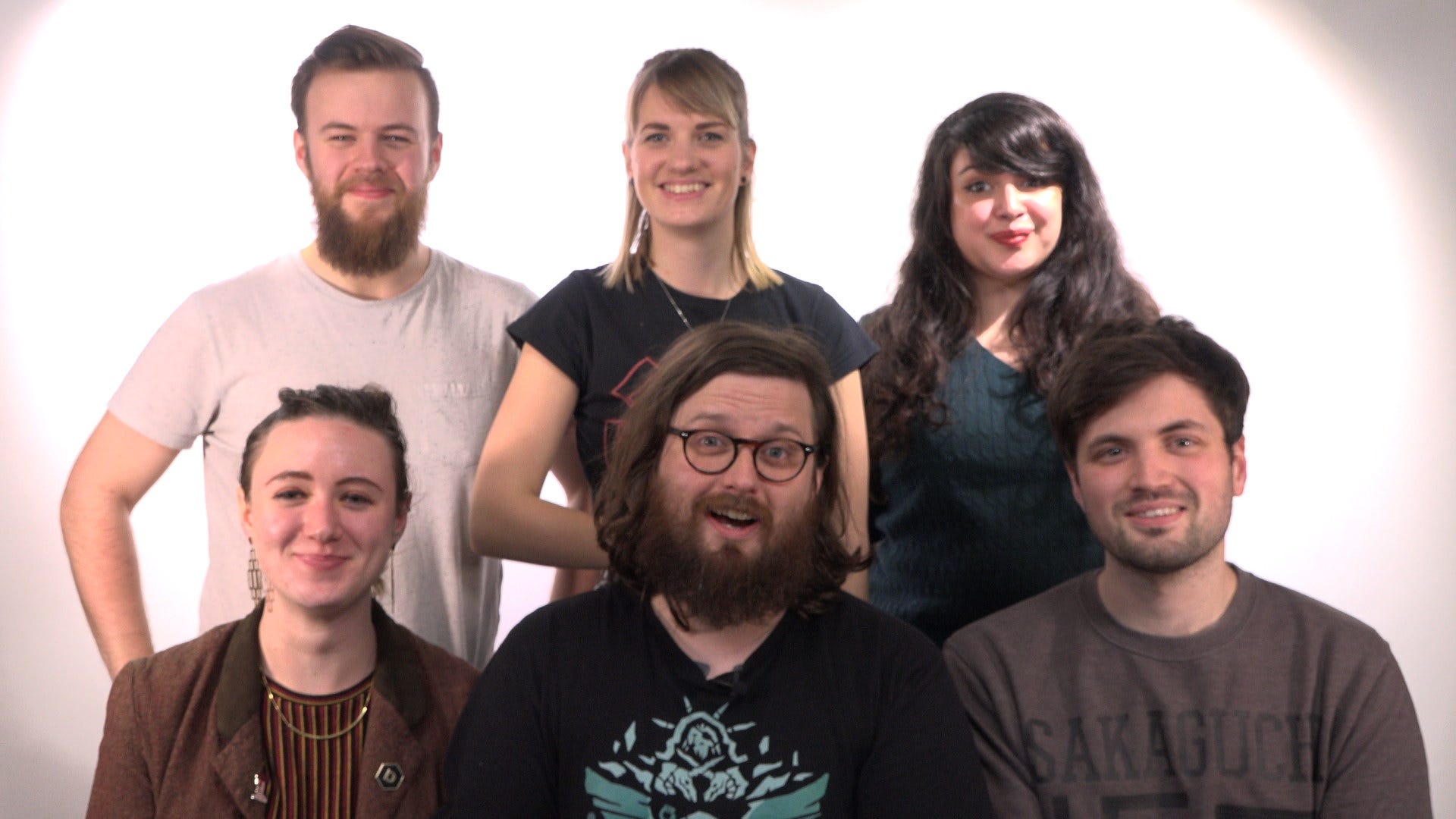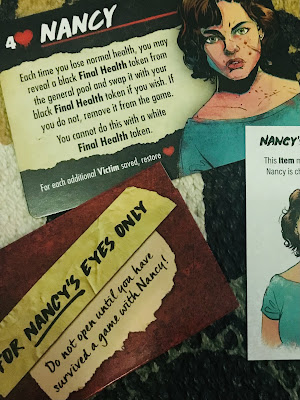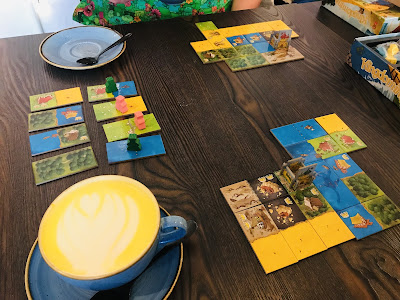Saturday, October 5, 2024
Review: Altered TCG - The new TCG on the block
Friday, October 4, 2024
Review: Paper App Dungeon - A Pencil Mightier Than The Sword
Regular readers will know that I'm a fan of any board game that can provide a solo experience. These are perfect for when your social battery is low or if you've got some time on a lunch break and need something with just the right amount of crunch to keep your mind off work. As such, games that are designed as a solo experience entirely and also fit neatly into a pocket, tend to get me excited. So you can imagine the thrill I felt when I slipped and fell into my Friendly Local Gaming Store (FLGS) and discovered Paper App Dungeon by Tom Brinton, published by Lucky Duck Games.
Paper App Dungeons, or PAD if you will (because it's like a note pad...), is a solo experience that puts one in mind of classic PC desktop, time-filler games. It has a charming retro style, simple colour palette, and comes with a pencil designed to act in place of a D6 (P6), which truly makes this one of the most portable and space-friendly games I own, beaten only by Regicide.
The aim of the game is ingeniously simple. Roll the P6 (one of my few criticisms of the game is that P6 is unpleasant to say out loud) and move through the dungeon that number of spaces. Diagonal on odd numbers and orthogonally on even numbers. The only catch is that you cannot change direction until you have moved the full number of spaces or you collide with an obstacle. Retracing steps is discouraged but not technically against the rules. In this fashion you work your way through each layer of the dungeon, looting chests, fighting monsters, and regaining health. Every so often there are "shops" where you can trade hard-earned coin for boosts, extra health, and other useful items to use in the coming levels.
This is where I get to my first major criticism of the format. The pages in each note pad are unique due to random generation so no two dungeons will look the same. This is fantastic in one sense as it allows for a high replay value if you choose to purchase multiple pads (though it is a shame they are essentially single use unless you want to go through and erase all your pencil markings, which is entirely possible). However, I found on my first playthrough that there is no clear difficulty curve. Hard levels were just as common as easy ones.
When playing, you carry health and coins over to the next level, unless you are killed, in which case you tally a death on the tombstone at the end of the book, and start the next level with full health and no coin. Sadly, what this inevitably translated to was my character dying right before I found my way to every shop location so I never had any money to spend on fancy upgrades. This left me feeling like I didn't really get to experience everything the game had to offer.
This frustration was compounded by what I would consider my second criticism, the lack of player autonomy. Although the player can choose the direction of travel, the limitation of travelling diagonally or orthogonally based on the result, coupled with the often tight spaces and the encouragement not to retrace steps, in practice doesn't leave much choice for the player. To be favourable, this does help in what I would call the game's "smooth brain" appeal, but there is a lingering feeling at points of the game playing itself, which the player gets to watch.
These points aside, I would still recommend this game to anyone who has ever used minesweeper or pinball desktop games to pass a scant amount of time. Each level takes no more than 5 minutes to complete, unless you are very unlucky and get trapped in a small corner, constantly rolling the wrong numbers of pinging off walls, which is quite funny to watch really. Plus the premise is so straightforward, it's a very age-accessible game.
The game comes in at under £10 in most retailers and I would say it certainly gives that back in entertainment value.
As a final note I would like to admit that I don't really understand why it's called Paper App Dungeon (OK I understand the first and third words, just not the second), so if anyone can enlighten me, I would appreciate it.
Have you played the game? Am I being too harsh in my criticism? Let me know in the comments down below.
Thursday, September 26, 2024
Play as an Act of Rebellion
The Culture of Defiance
 |
| Regicide - Abrahams et al. |
Skye Jones and Lex Lancaster, University of South Carolina Upstate, wrote that Kawaii culture in Japan was an act of rebellion by young girls against the oppressive culture of "conformity and gendered expectations". Kawaii's emphasis on the hyper-feminine and "cute", which it is a direct translation to, promoted an attitude of vulnerability and childishness that directly contrasted against the societal expectations of responsibility and uniformity in post-war Japan, rising to its peak in the 1970s. In particular the prevailing narrative in Kawaii media is the "magical girl", which is/was distinct from typical Japanese media of the time due to the depiction of everyday girls as "interesting and important people". In this respect Kawaii acted as a strike back at the social narrative that women in positions of prominence are separated from their peers, and are only permitted to have nuance and power if they actively distance themselves from "girlhood" and childish things.
"Kawaii... is most associated with a complete rejection of refinement and beauty, focussing on a childlike attitude of vulnerability, overindulgence, and fantasy." - Jones & Lancaster
At the same time that Kawaii was growing into the powerful youth and feminist movement that it is, in the UK a similar rejection of authority and oppression was kicking its way into the public consciousness; Punk. Much like it's cute sibling on the other side of the world, the youth in the UK embraced Punk and its intentionally unpleasant and viscous aesthetic.
Matthew Worley, writing for the Museum of Youth Culture, concisely summarised Punk as "a negation of pretty much everything: a line drawn in the cultural sand to reboot and rejuvenate youth culture as a site of provocative fun, protest, and imagination". The way in which Kawaii kicked back at oppressive social norms through the hyper-cute, Punk used its vibrant aesthetics and attitudes to take a swing at the muted compliance expected of the British public at the time. Hand in hand, Kawaii and Punk, rejected the status quo and acted in an exaggerated, non-conforming way to undermine the systems of oppression.
I'm not going to fall into the trap that so many columnists have fallen into, and state that something (let's face it, usually right-wing) is the new punk (I'd argue that punk is still the new punk). But I am going to state that in the modern, western world, playing is an act of rebellion.
Can't Spell Punk-tuality Without Punk
(See me about this heading - ed.)
 |
| A punk in the wild |
Never has it been more obvious that when Millennials entered the workforce, that western, capitalist society has been constructed on the premise that childish interests should be abandoned or repressed on becoming an adult. Play for adults traditionally falls into the realms of socially acceptable sports and gambling. There seems very little room for playing video games or those that involve the imagination or little plastic figurines (let's face it, they're toys). I am sure that many readers here will have experiences of telling members of the older generation, or perhaps some more socially acceptable peers, that they spent their weekend pretending to be a wizard fighting a floating one-eyed monster that can shoot laser beams. There is little that can fill that peculiar silence that follows...
However, many millenials entered the workforce still very much attached to their childhoods, which seemed only to be exacerbated by the harsh economic realities of the times. This yearning for the simpler times before gas bills, shopping lists, and mortgages (for those lucky enough to own a house), created almost an entire generation with a meager expendable income keen to channel it into playful pastimes and hobbies. Of course, these traits aren't only held by millenials, but it cannot be ignored that the vast growth in the video games industry in the decade leading up to 2020 and beyond.
Dave Neale, an Affliate of the Centre for Research on Play in Education, Development and Learning (PEDAL) at the University of Cambridge and designer of many board games, writing for the British Psychological Society, noted that there has also been a rise in other "play experiences" for adults as well.
"This is striking because it is at odds with the dominant view in Western culture... that play is largely confined to childhood." - Neale
Neal makes the case that play and playfulness are more central to adult humans than commonly believed. In most other cases animals leave behind playfulness following adolescence. However, humans experience a "persistence of our child-like qualities". The reason for this is posited as an evolutionary benefit. The retention of child-like characteristics like curiosity and "behavioral plasticity... drove our success as a species".
Furthermore, Neal cites Whitebread et al., 2017, in offering an explanation for the retention of playfulness as the psychological benefits similar to those proposed for childhood play. There is a growing body of research exploring the benefits of play in adults and various aspects of adult life. It is becoming more obvious that play is healthy for adults and society as a whole will reap the benefits of a mentally healthy and socially satisfied work-force.
Is It All Just a Worker-Placement Game?
 |
| Stardew Valley - |
Despite this, it is still clear that society is built to ensure constant growth and productivity. The core requirements of late-stage capitalism are fundamentally at odds with the concept of providing adults with play. Although time spent playing is constructive in terms of mental well being, which in turn could produce positive benefits in the work place, it still feels that it is under-valued at best and actively discouraged at worst.
I suspect that the reason for this is that it benefits the worker primarily and the capitalist secondarily. Whereas typically benefits to the worker are largely only encouraged where the business owner is the primary target of the benefit.
Neal does dip his toes into territory that I would consider troubling. In his article for the British Psychological Society, he cites companies such as Google that provide employees with "play areas" to make play a part of working life. The following passage shows how Neal suggests incorporating play into the workplace:
"... Introducing play into the workplace needs to be done with care to be effective. For example, games need to be designed to engage and motivate players, and to accurately reflect workplace objectives. Otherwise, it is possible for employees to use games as escapism, or for games to lead to learning outcomes that are not work-relevant, or even detrimental to work. Play can easily become a distraction, or trivialise serious issues, if it is not introduced in the right way (which may be the thinking behind the traditional play-work dichotomy)."
While I agree with the management of play to reduce the risk of it trivialising serious issues, I find the concept of play only tolerated where it can benefit the employer concering. This feels sinister and potentially weaponises play against the worker to ensure continued compliance. I am particularly curious as to what Neal thinks constitutes learning outcomes that are "detrimental to work". Benefits for workers? Unionisation? Seizing the means of production? And gods forbid workers should use any activity as a form of escapism! It might give them ideas of freedom.
This recommendation of the use of play to ensure productivity, for me, removes the player as the core beneficiary of the activity and further creates a system where play is only tolerated in adults if a tangible productive outcome can be measured and exploited.
Stick It to the Man Meeple
 |
| Final Girl: Terror from Above - Porfirio et al. |
So what do I really mean when I say that play is act of rebellion?
Well, firstly I believe that any activity which puts the benefits of the worker above that of the ruler is a good thing. If playing provides a stronger sense of connection, education, and well being to the players and cannot be exploited to feed into the Constant Growth Machine, it is undeniable an active stand against oppression.
Secondly, as seen in the Kawaii and Punk movements, there is nothing an oppressive society is more intolerant of that the demonised happily adopting the branding put on them. If cute and childlike traits are branded as undesirable, Kawaii took that ore and turned it into iron (pink, sparkly iron with big round eyes). If being loud and unfeminine are traits branded as undesirable, Punk put a safety pin through them and wore them like armour against oppression. So if spending time on playing games is seen as undesirable and unproductive in adults, then playing games in-spite of that becomes rebellious.
Finally, and bringing this firmly back into the realms of table top gaming, if playing is seen as an act of rebellion against a society bent towards endless productivity, then in an increasingly digital world, a world in which large tech companies can stake claim to every aspect of our presence online, playing table top games, away from the digital realm, is the purest form of rebellion.
(I would like to caveat this all with the understanding that many will claim that without capitalism and the digital world, I would not be able to write a post like this online about games produced by the likes of Hasbro. To those people I would like to point them in the direction of the politics and ethics section of their local library where they can read up a bit better on the concepts of socialism).
This is an opinion piece, of course, so I would like to hear what people think about the statement "Play is and Act of Rebellion".
Tuesday, June 18, 2024
It Tolls for Thee: A Eulogy for Dicebreaker
"No man is an island,Entire of itself.Each is a piece of the continent,A part of the main.If a clod be washed away by the sea,Europe is the less.As well as if a promontory were.As well as if a manor of thine ownOr of thine friend's were.Each man's death diminished me,For I am involved in mankind.Therefore, send not to nowFor whom the bell tolls,It tolls for thee."-John Donne
Thursday, July 27, 2023
Chaos is a (Snakes and) Ladder: 5 chaotic games for all you lil' goblins
Last year Oxford English Dictionary declared Goblin Mode as Word of the Year. This, on the face of it, was a joyous occasion for all the Lil' Goblins out there. Until the OED stated what their chosen definition of the phrase was:
Goblin Mode (Noun): The behaviour of someone who wants to feel comfortable and do and eat whatever they want, not caring about trying to be clean, healthy or attractive, or about pleasing or impressing other people.
As an honorary member of the Goblin Contingent of the Hand Limit board game group, I can only begin to describe the frustration of my goblin comrades at this unworthy definition. Sure goblins may occasionally shun hygiene standards, sure they might survive for days on a diet of cereal and gummy worms, and sure they might sometimes present themselves in a way that doesn't comply with society's standards of beauty, but this is all part of a wider shunning of societal expectations and pressures in favour of running wildly off into the woods to worship an interesting looking mushroom, or eat a loaf of bread right out of the bag. It is so much more than the desire for comfort!
Goblins are emerging from the desire for chaos to replace late-stage capitalism. We all have an inherent desire to rid ourselves of the shackles of oppressive standards and embrace the chaos of the natural world.
So, for all you Lil' Goblins out there, here's 5 table top games that will help you embrace the chaos and unleash your inner goblin.
Happy Salmon, Ken Gruhl et al. Exploding Kittens
3-6 Players (3-12 with 2 sets). 2 minutes.
Cheating Moth, Emely Brand & Lukas Brand. Drei Magier Spiel.
3-5 Players. 30 minutes.
What could be more chaotic than a game that encourages, neigh requires, cheating to win?
At it's base level, Cheating Moth is another simple card game in the vein of Uno. First person to rid themselves of all their cards wins. Players take it in turns to play numerical cards into a central pile that value one higher or lower than the last card played. There are also cards that trigger certain effects, like the spider card that allows a player to give one of their cards to another, or the mosquito that punishes the last player to slap it with more cards into their hand.
Oh and did I mention that it's totally fine if you want to just ditch cards beneath the table, up your sleeve, or maybe into a friend's packet of crisps?
Here we see the cheating of cheating moth. Within certain parameters, players are allowed to dispose of cards however they see fit provided they can get away without being seen by the "Guard Bug", a random player who may not cheat but must keep an eye out for players who are. If they successfully catch a player cheating, the cheater becomes the Guard Bug, until someone manages to spirit away their entire hand.
Cheating is essential. The eponymous Cheating Moth card may only be removed from your hand through cheating. It cannot be played legally.
This is another incredibly simple game that is filled with chaos as cards are slipped into pot plants, spun across the room right beneath an unsuspecting Guard Bug's nose, or someone stands up at the end of the game to reveal quite how many cards they were hiding up their top.
When you realise quite how sleight your friends' sleight-of-hand can be, you'll find it hard to look at them the same way again!
Wiz-Nerds - TTRPG, Michael Whelan. Available on itch.io.
1+ Players, 1 GM. 2-3 Hours (chaos depending).
Blood Bowl Sevens, Games Workshop.
2 Players. 45-90 minutes.
Camel Up (2nd Edition), Steffen Bogen. Eggertspiele.
3-8 Players. 45 minutes.
What's more chaotic than a game where none of the players are actually controlling the pieces on the board? In Camel Up 2nd Edition players take the roles of pundits at a camel race, placing bets on camels in the hope of ending the game with the most money.
However, working out form and probability is nigh on impossible when the camels move at random speeds (sometimes not at all), hitch rides on each other's backs, or simple run the wrong way around the course carrying any hapless camels with them.
Races are separated into Legs, which each carry their own smaller bets and allow for players' fortunes to rise and fall throughout the game. Someone getting off to an early lead might lose everything when the camel they were betting on gets carried to the back of the pack by the pair of wild camels that run the wrong way round the track each race.
This is an accessible game for almost the whole family (younger children might get a bit lost with the betting mechanics but will still enjoy making the dice roll out of the 3D plastic pyramid) and differs from the others on this list in that players are not actively participating in the chaos. Instead you can sit back, sip a mint julep, and enjoy the unfolding shambles.
Special Mention: Colt Express, Christophe Raimbault. Ludonaute.
2-6 Players. 45 minutes.
Is there a game that should have appeared on this list? What's your most chaotic table top tale you have (within the realms of the rules - no table flipping)? We'd love to hear what you think in the comments section below.
Thursday, July 6, 2023
Review: Final Girl - A board game with a Killer theme
I'm sure we're all familiar enough with horror films to recognise the "final girl" trope. This is the character (due to convention it tends to be a female character) who is left standing at the end of a horror film surrounded by the remains of her fallen companions, usually victorious in defeating or evading the horror that has pursued them for the last 90 minutes. She often portrays some characteristic that the film-makers, or society, feels embodies the one "worthy" of survival. Perhaps she has been the voice of reason, compassion, or she's simply a virgin and therefore not deserving of a gruesome death.
This character has managed to stick it out to the end, either through kick-ass bravery, or just screaming and stumbling far enough through the woods that they get picked up at the highway. Their journey has been transformative, terrifying, and usually good for 3-4 sequels.
Final Girl, the board game now on "Season 2" releases (I'll get into how that works more below), places you in the shoes of one of many possible, and legally distinct, Final Girls. You are constantly caught on the back foot, fighting for time, and a helpless witness to the growing horror of the situation, while given just enough hope to see a glimmer of light at the end of the tunnel. Final Girl has condensed this age-old scenario into a loving homage to the many, many hours of screen time given over to our favourite horror cliché.
How do we kill something that's... already dead?!
He was never really dead...
He's slicing off his own fingers!
Wednesday, May 17, 2023
Can playing board games help us cope with failure?
I have a simple rule with any board game: I am not happy until I've lost as many or more times than I have won. Losing in cooperative or competitive gaming is just as important for the enjoyment of the game as winning and a well designed game will recognise this and reward effort with entertainment, but how can losing at games help us in our daily lives?
Featured Article
Games on Location: Episode 3 - The Bloody Inn
Episode 3 of Games on Location is taking a morbid turn with Nicolas Robert's The Bloody Inn, published by Pearl Games. With Spooky Seaso...
Most Popular Post
-
With less than a month to go preparations are well under way for the first ever Hand Limit event and it's exciting to see everything com...
























.jpg)